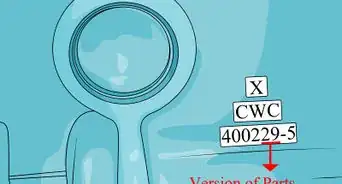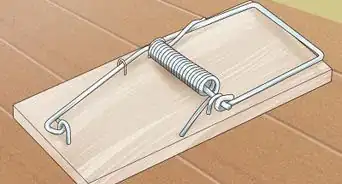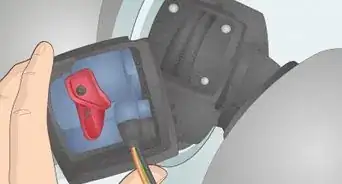wikiHow is a “wiki,” similar to Wikipedia, which means that many of our articles are co-written by multiple authors. To create this article, 10 people, some anonymous, worked to edit and improve it over time.
There are 7 references cited in this article, which can be found at the bottom of the page.
This article has been viewed 70,283 times.
Learn more...
The VW engine runs hotter than a water cooled engine, and so it gives the oil a harder workout. Frequent oil changes are the best preventive maintenance you can give your VW engine, because aging oil becomes diluted and contaminated, leading to premature engine wear. If you check the oil every other gas fill-up, low oil condition should never occur. If it does, there is a serious leak from the crankcase or the engine is burning oil (blue smoke).
Steps
-
1Assemble the required tools:
- Drain pan.
- Rags.
- 3/8"-drive ratchet and appropriate sockets.
- 1/4"-drive ratchet and 10mm socket.
- Newspapers.
- A large coffee can for cleaning parts in.
- A container for the waste oil.
-
2Start the car and drive it around to warm it up.[1]Advertisement
-
3Park the car on a level spot.
-
4Locate the oil sump plate on the bottom of the engine. It is held to the engine case with a number of very small nuts.
- The oil sump plate may have a drain plug in the center.
- From 1973 onwards, VW left the drain plug out to make sure that the sump plate and screen were removed for cleaning with each oil change. You can fit an original plate with a drain plug from an older beetle model.It is o.k. to clean then the sump plate after every 2nd oil change. Modern motor oils last longer.
-
5Place the drain pan under the bottom of the sump.[2]
- If the oil sump plate has a center drain plug, unscrew it and let the oil drain into the pan.
- If the oil sump plate doesn't have the center drain plug, loosen (but do not remove) the small nuts around the perimeter of the sump plate.
- Once most of the nuts are loosened the oil will start to drain from around the sump plate.
- Once the oil has completely drained, remove the nuts from around the perimeter of the oil screen sump plate.
-
6Remove the sump plate and screen and place all of the removed parts in a can for cleaning.
-
7Clean oil sludge off the sump plate.[3]
- Make sure that none of the old gasket remains stuck to the sealing surfaces. Remove with a scraper if necessary.
- Clean up the sealing surfaces on the bottom of the engine case with a rag. Clean the sealing surfaces thoroughly to assure the new gaskets will keep your oil in where it belongs.
-
8Hold the oil screen up like it goes into the engine, then put one gasket over it on the engine side, to match up with the holes.[4]
- Place the oil screen and gasket into the engine where it goes, then put the other gasket on.
- Put the sump plate over the screen and start the nuts (with new crush washers on each one) and the center drain plug (where applicable). Some experts recommend replacing the stock oil plug with a magnetic oil plug. The magnet will pick up metal particles preventing them from circulation throughout the oil system.
- DON'T use gasket-goo or other sealants.
-
9Tighten the nuts around the perimeter of the sump plate.
- DO NOT OVER TIGHTEN THE SUMP PLATE NUTS!
- The proper torque for these nuts is only 5 feet (1.5 m)-lbs.
- If you tighten them anymore, you're likely to either strip the stud or pull it out of the case.
-
10After the nuts are tighten, tighten the center drain plug if applicable.
-
11Put in 2.5 liters (0.7 US gal) of new oil.[5] Use a spout or funnel if necessary to prevent oil from spilling onto the top of the engine.
- Wait a few minutes to allow the oil to drain into the sump, then check the level on the oil dipstick.
- Add oil as necessary to bring the level to near the top mark. DO NOT overfill.
-
12Start the engine and check to make sure the oil pressure light goes out after the engine has started.
- While the engine is running, look under the car and check for leaks around the cover plate.
- Tighten the nuts if necessary.
-
13Turn off the engine and wait a few minutes to allow the oil to trickle down to the sump. Recheck the level on the dipstick and add oil if necessary.[6]
Community Q&A
-
QuestionWhat happens if I put in too much oil?
 Community AnswerWhen too much oil is added to the engine, air gets mixed into the oil, creating a "foam". This foam can damage piston seals and cannot properly recirculate. Over time, having too much oil in your car can trash the engine.
Community AnswerWhen too much oil is added to the engine, air gets mixed into the oil, creating a "foam". This foam can damage piston seals and cannot properly recirculate. Over time, having too much oil in your car can trash the engine. -
QuestionWhat oil do I need in my Volkswagen Beetle if it is summertime and I am in a hot climate?
 Community AnswerCastrol GTX 10w/50w in summer works great. In winter, change to a lower viscosity, i.e. 10w/40w or 10w/30w.
Community AnswerCastrol GTX 10w/50w in summer works great. In winter, change to a lower viscosity, i.e. 10w/40w or 10w/30w. -
QuestionWhat oil grade should I use for a 1964 Mach 1 Beetle?
 Community Answer10W30 is best in most climates.
Community Answer10W30 is best in most climates.
Warnings
- Safety should always be your #1 focus when working on a vehicle. ABSOLUTELY NOTHING in this world is so important, that you should EVER practice unsafe maintenance on your vehicles. Always use the proper tools for the job at hand. Common sense is a VERY IMPORTANT.⧼thumbs_response⧽
References
- ↑ https://www.youtube.com/watch?v=LJD28DD4fT4
- ↑ https://www.reluctantmechanic.com/step-by-step/vw_beetle_oil_change.php
- ↑ https://www.youtube.com/watch?v=SNeMQvsENkY
- ↑ https://www.youtube.com/watch?v=VYBQ7hq1mVo
- ↑ https://youtu.be/LJD28DD4fT4?t=715
- ↑ https://www.vwheritage.com/blog/2017/04/06/vw-air-cooled-oil-servicing-tips/
- ↑ https://www.epa.gov/recycle/managing-reusing-and-recycling-used-oil
-Beetle-Step-1.webp)
-Beetle-Step-2.webp)
-Beetle-Step-3.webp)
-Beetle-Step-4.webp)
-Beetle-Step-5.webp)
-Beetle-Step-6.webp)
-Beetle-Step-7.webp)
-Beetle-Step-8.webp)
-Beetle-Step-9.webp)
-Beetle-Step-10.webp)
-Beetle-Step-11.webp)
-Beetle-Step-12.webp)
-Beetle-Step-13.webp)
-Beetle-Step-9.webp)
-Beetle-Step-5-Version-3.webp)



















-Beetle-Step-9.webp)
-Beetle-Step-5-Version-3.webp)




































